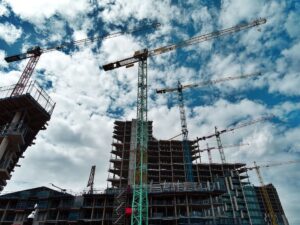
Government construction management, a crucial aspect of public sector infrastructure development, involves the intricate coordination of various elements, from budgeting and compliance to technology integration and workforce management. These projects, often characterized by their large scale and public impact, demand meticulous oversight and strategic planning. In facing the unique challenges of this sector, it’s imperative to identify effective solutions that ensure the successful and efficient completion of construction projects.
Regulatory Compliance
Navigating the labyrinth of regulations in government construction is a daunting task. Projects must adhere to a complex web of local, state, and federal laws, which can vary significantly based on the project’s nature and location. This compliance challenge extends beyond mere adherence to laws; it involves understanding and integrating these regulations into every project phase, from planning to execution. The solution lies in a proactive approach – employing legal and environmental experts who specialize in construction regulations. These professionals can offer valuable insights, ensuring that projects meet current standards and are adaptable to regulatory changes. Additionally, investing in compliance training for the project team fosters a culture of awareness and responsibility, further safeguarding projects against legal pitfalls.
Budget Constraints
Managing finances in government construction projects is a balancing act. With budget constraints and the need for fiscal accountability, effective financial stewardship becomes paramount. This challenge requires a comprehensive understanding of the project’s financial landscape – from initial cost estimates to long-term maintenance considerations. Solutions include employing advanced budgeting software and financial management techniques that offer real-time tracking and forecasting abilities. This approach enables managers to make informed decisions, identifying potential cost overruns early and adjusting plans accordingly. Moreover, promoting a culture of cost-consciousness among the team and stakeholders can help in identifying cost-saving opportunities, thereby maximizing the value derived from limited public funds.
Time Management
Timely completion of government construction projects is critical. Delays can have far-reaching consequences, from increased costs to public dissatisfaction. Effective time management requires a multifaceted strategy. Firstly, comprehensive project scheduling, detailing every phase and milestone, is essential. This schedule should be realistic, accounting for potential delays and incorporating buffer periods. Regular progress monitoring, through both on-site inspections and digital tracking tools, ensures that the project stays on track. In the case of delays, having a well-thought-out contingency plan enables quick and effective responses, minimizing the impact on the overall project timeline. Engaging the entire project team in time management efforts, from contractors to suppliers, ensures a cohesive approach to meeting deadlines.
Quality Control
Maintaining high-quality standards in government construction projects is imperative. Quality control challenges are multifaceted, stemming from factors like contractor performance, material standards, and adherence to design specifications. To ensure quality, rigorous quality assurance protocols must be established. This involves regular inspections, both scheduled and random, to monitor compliance with set standards. Employing quality control managers who specialize in government projects can provide the expertise necessary for overseeing these processes. Additionally, fostering a quality-centric culture within the project team encourages everyone to uphold high standards, thereby reducing the likelihood of defects and ensuring the longevity and safety of the constructed infrastructure.
Stakeholder Engagement
Effectively managing stakeholder engagement is vital in government construction projects. The challenge lies in balancing the interests and expectations of diverse groups, including government entities, contractors, and the public. Effective stakeholder engagement requires transparent communication strategies. Regular updates, public meetings, and open channels for feedback can foster a sense of involvement and trust. Involving stakeholders in the decision-making process, where feasible, can also provide valuable insights and increase project acceptance. Moreover, addressing concerns promptly and efficiently minimizes conflicts and builds positive relationships, contributing to smoother project execution.
Technology Integration
The integration of technology in government construction management is no longer optional but a necessity. The use of management software for federal building construction exemplifies this shift. This software provides a comprehensive platform for government construction management, encompassing aspects such as resource allocation, compliance tracking, and performance monitoring. Its real-time data analysis capabilities are invaluable for decision-making, allowing managers to respond swiftly to changing project dynamics. Furthermore, embracing other technological innovations, such as Building Information Modeling (BIM) and Geographic Information Systems (GIS), can enhance project planning and execution. These tools offer a more accurate and detailed understanding of the project, facilitating better design and construction practices.
Environmental Sustainability
Environmental sustainability is increasingly at the forefront of government construction. Challenges in this area include minimizing the environmental impact of construction activities and ensuring compliance with sustainability standards. Solutions involve a holistic approach to sustainable construction practices. This includes using eco-friendly materials, employing energy-efficient design principles, and incorporating renewable energy sources where possible. Beyond these technical aspects, promoting sustainability awareness among the project team and stakeholders can lead to more environmentally conscious decisions. Additionally, regular environmental impact assessments can help identify potential issues early, allowing for timely corrective actions.
Risk Management
Risk management in government construction encompasses a wide range of concerns, from on-site safety to financial stability. Identifying and mitigating these risks requires a comprehensive strategy. Regular risk assessments, conducted at different project stages, help in understanding and preparing for potential issues. Implementing safety protocols and conducting training sessions enhances on-site safety, reducing the likelihood of accidents. Financial risks can be managed through insurance and by maintaining a contingency fund. Additionally, establishing clear communication channels for reporting and addressing risks ensures that issues are dealt with promptly, mitigating their impact on the project.
Workforce Management
Effective workforce management is crucial for the success of government construction projects. Challenges include not only ensuring adequate staffing levels but also managing workforce diversity, skill development, and compliance with labor laws. Solutions involve strategic workforce planning, identifying skill gaps and recruiting accordingly. Investing in training and development programs enhances the team’s capabilities, adapting to the evolving demands of the construction industry. Moreover, fostering a positive work environment and offering competitive compensation can attract and retain skilled professionals, ensuring a motivated and efficient workforce.
Supply Chain Management
Efficient supply chain management is essential for timely and cost-effective construction. Challenges include dealing with material shortages, logistical delays, and supplier reliability. Establishing strong, long-term relationships with suppliers can ensure a more reliable material supply. Implementing advanced inventory management systems, including just-in-time delivery methods, can reduce storage costs and minimize the risk of material shortages. Additionally, diversifying the supplier base can provide alternatives in case of disruptions, ensuring the steady flow of materials required for uninterrupted project progress.
Innovation and Research
Staying abreast of innovation and research is vital in the ever-evolving field of government construction. Challenges include integrating cutting-edge technologies and methodologies into existing practices. Investing in research and development initiatives can bring innovative solutions to construction challenges, enhancing efficiency and effectiveness. Collaborating with academic institutions and industry experts can provide access to the latest research and technological advancements. Encouraging a culture of innovation within the project team can also lead to creative problem-solving approaches, driving continuous improvement in construction practices.
Security and Privacy
Security and privacy in government construction projects are of utmost importance, particularly in projects of national significance. Challenges include protecting sensitive data and ensuring physical security at construction sites. Implementing robust cybersecurity measures, such as encryption and access controls, safeguards digital information. On-site security protocols, including surveillance and restricted access, protect the physical integrity of the project. Regular security audits and updates ensure that these measures remain effective against evolving threats, providing a secure environment for construction activities.
Final Thoughts
Government construction management is a field fraught with complex challenges, each requiring a strategic and thoughtful approach. From ensuring regulatory compliance and financial prudence to embracing technological innovations and prioritizing environmental sustainability, these challenges call for a comprehensive and dynamic management strategy.






